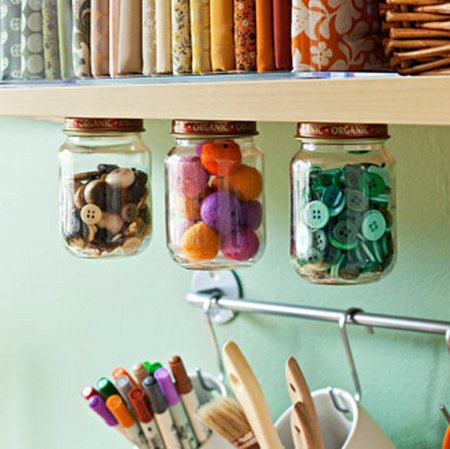Hooked on recycling.
Friday, March 30, 2012
Why Permaculture Folks Love Comfrey
Source: http://www.permies.com
Comfrey may be the most talked about permaculture plant. It is commonly planted under fruit trees because it does not compete with tree roots, but it does compete with plants that do compete with tree roots.
Alexia Allen of Hawthorn Farm tell us how she like using it as a poultice. We get to see bees and ants racing for the nectar of the comfrey blossoms. She also feeds it to her animals.
Toby Hemenway is the author of "Gaia's Garden: A Guide to Home-Scale Permaculture." He calls comfrey "the queen of the multi function plants." He talks a little about how easily it can spread when you don't want it. And then he talks about how he is able to get rid of it through mulching - but why would you not want it? It's a beneficial insect attractor; it is able to heal wounds; a dynamic nutrient accumulator; good for under fruit trees; good for a comfrey tree for soils; a huge biomass accumulator.
Tulsey Latoski of Portland, Oregon tells us about how comfrey makes a great green manure and living mulch. Mostly due to the tap roots that will pull nutrients up from down deep. She also shows us two different types of comfrey.
Norris Thomlinson of Portland, Oregon shares some observations about how comfrey fares as chicken feed; edible plant for humans; medicinal plant for humans;
Michael Pilarski is a famous wildcrafter and permaculture consultant.http://www.friendsofthetrees.net He tells us about how comfrey sluff material off into the soil to make for a richer soil. Apparently earthworms love comfrey! Michael tells us how comfrey is sometimes called "knit-bone" because it proliferates cell division - a great healer. His spring salads are loaded with comfrey leaves and blossoms. Michael talks about Dr. James Duke says that one bottle of beer has the same level of dangerous alkaloids as 100 cups of comfrey tea.
Matt from Feral Farm shows an understory heavy with comfrey.
Brian Kerkvliet of Inspiration Farm in Bellingham, Washington, talks about the challenges of getting comfrey out of an area where you don't want it. He uses a hot compost pile on top of it. He also shares the idea that if you have comfrey, that's a great place to plant a fruit tree! Then he shows a permaculture guild that includes comfrey.
Samantha Lewis describes how to tell the difference between comfrey, foxglove, mullein and borage.
Toby Hemenway wraps up with who is the king of the permaculture multifunctional plants (spoiler: bamboo!)
Relevant threads at permies:
http://www.permies.com/t/10864/organic-sustainable-practices/comfrey
http://www.permies.com/t/1174/permaculture/value-comfrey
http://www.permies.com/t/6888/permaculture/Comfrey-cultivars-life-expectancy
http://www.permies.com/t/11140/permaculture/Corn-Comfrey-Large-scale-polyculture
music by Jimmy Pardo
Comfrey may be the most talked about permaculture plant. It is commonly planted under fruit trees because it does not compete with tree roots, but it does compete with plants that do compete with tree roots.
Alexia Allen of Hawthorn Farm tell us how she like using it as a poultice. We get to see bees and ants racing for the nectar of the comfrey blossoms. She also feeds it to her animals.
Toby Hemenway is the author of "Gaia's Garden: A Guide to Home-Scale Permaculture." He calls comfrey "the queen of the multi function plants." He talks a little about how easily it can spread when you don't want it. And then he talks about how he is able to get rid of it through mulching - but why would you not want it? It's a beneficial insect attractor; it is able to heal wounds; a dynamic nutrient accumulator; good for under fruit trees; good for a comfrey tree for soils; a huge biomass accumulator.
Tulsey Latoski of Portland, Oregon tells us about how comfrey makes a great green manure and living mulch. Mostly due to the tap roots that will pull nutrients up from down deep. She also shows us two different types of comfrey.
Norris Thomlinson of Portland, Oregon shares some observations about how comfrey fares as chicken feed; edible plant for humans; medicinal plant for humans;
Michael Pilarski is a famous wildcrafter and permaculture consultant.http://www.friendsofthetrees.net He tells us about how comfrey sluff material off into the soil to make for a richer soil. Apparently earthworms love comfrey! Michael tells us how comfrey is sometimes called "knit-bone" because it proliferates cell division - a great healer. His spring salads are loaded with comfrey leaves and blossoms. Michael talks about Dr. James Duke says that one bottle of beer has the same level of dangerous alkaloids as 100 cups of comfrey tea.
Matt from Feral Farm shows an understory heavy with comfrey.
Brian Kerkvliet of Inspiration Farm in Bellingham, Washington, talks about the challenges of getting comfrey out of an area where you don't want it. He uses a hot compost pile on top of it. He also shares the idea that if you have comfrey, that's a great place to plant a fruit tree! Then he shows a permaculture guild that includes comfrey.
Samantha Lewis describes how to tell the difference between comfrey, foxglove, mullein and borage.
Toby Hemenway wraps up with who is the king of the permaculture multifunctional plants (spoiler: bamboo!)
Relevant threads at permies:
http://www.permies.com/t/10864/organic-sustainable-practices/comfrey
http://www.permies.com/t/1174/permaculture/value-comfrey
http://www.permies.com/t/6888/permaculture/Comfrey-cultivars-life-expectancy
http://www.permies.com/t/11140/permaculture/Corn-Comfrey-Large-scale-polyculture
music by Jimmy Pardo
Urban Permaculture - SF
Many valuable reflections of how Permaculture is more than just gardening, and how it brings the community together.
Thursday, March 29, 2012
Recycled Cardboard Tube: A Bird Feeder
Birds are an important diversity factor of the Permaculture garden. The provide pest control, pollination, company and and of course, beautiful music!
Orlando Permaculture - Natasha
Natasha shares some of her design goals and ideas for a private home owner in the Orlando, Florida area (sub-tropical). She illustrates the thought process of permaculture design when looking at a landscape.
Recycled Suitcases


I think the common element here is "For medicinal use".
Recycled Boat Planter
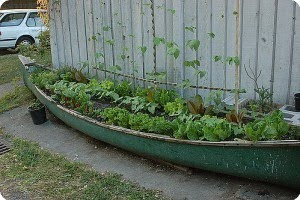
Sitting in a garden is the cure for sea-sickness.
Small Scale and Urban Food Production
Geoff Lawton of the Permaculture Institute of Australia talks about a chicken lot design for cyclic chicken tractoring while another garden grows, and city agriculture production.
"At present one of the things that's really in surplus in our cities is organic matter. We have lots of it. And the thing about our cities are that they're full of hardware that runs off water. and they're a great micro-climate. There's lots of thermal mass that gains heat. And there's lots of sheltering from wind. So you can design city production. Urban agriculture and perimeter urban agriculture is much more productive than open space agriculture. So it's something that we're going to see more of."
Wednesday, March 28, 2012
Chicken Tunnel Man
http://www.ecofilms.com.au/ Bruce Morgan is into making his chickens do the work around the house using a series of wire tunnels.
Table Top Bar (or Herb Garden!)
Just swap the middle board with a rain gutter for instant Table Top Bar.
...or... How about drilling some small drainage holes in the bottom of it and growing your favourite culinary herbs?
The Winter Cover Crop
Make the most out of your Spring Garden! See why the winter cover cropping is worth it.
"So we've got all this beautiful organic matter. We've got nitrogen in here. Earthworms. I mean it's just like CAKE! So how much better can it get? I don't know."
Tuesday, March 27, 2012
A Sheet Mulched Keyhole Garden
A limestone drystack garden being built with sheet mulching methods to
improve soil health and conserve water. The keyhole design allows
maximum garden space and minimum pathway for increased veggie production
capacity.
Jo Dyantyi's Permaculture Food Forest Garden
An inspiring and touching video of a man who has made friends with the land he's living on.
"It feeds more than me. It feeds many, many people ... It's the land. The land is doing all the providing ... It's all in the process of development. Everything will change. You see, you start and once you start you get a vision. You start directing. Ah! Like this, like that ... you get more and more inspired."
Recycled Bottle Broom
Another one of those things you look at and think "I could have thought of that!"
Apologies: source unknown. It was emailed to me.
Update:
Thanks to Permaculture Ideas visitor Mr.Sorightz I was asked for more info and found the original post (translated). Enjoy:
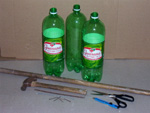
What you need:
- 20 plastic soft drink bottles 2 liter PET
- broomstick
- scissors
- stylus
- awl
- wire
- hammer
- nails
Steps:
| 1. Remove the label on the bottle. | 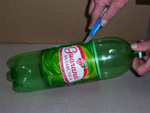 |
| 2. Remove the bottom of the bottle, with the cutting stylus. | 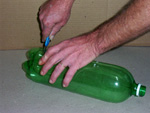 |
| 3. Make cuts in the bottle up to the more rounded
The bottle will keep strips approximately 0.5 cm.
|  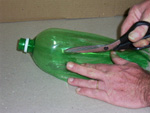 |
| 4. Remove the neck with scissors. | 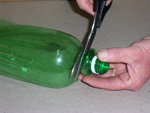 |
| 5. Make 18 pieces without neck and leave with a bottleneck. | 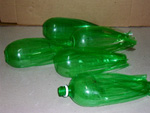 |
| 6. Fitting parts with no neck, one by one over the part with neck. Are you ready base of the broom |  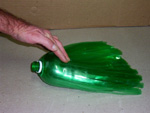 |
| 7. Cut the top of another bottle and fit over the base of the broom you just prepared | 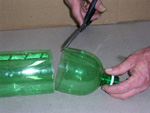 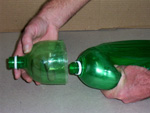 |
| 8. Drill two holes and insert the wire through all layers of bottles |  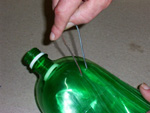 |
| 9. Pull the wire to the other side and twist the ends to fasten |  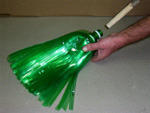 |
| 10. Secure parts with the aid of two nails | 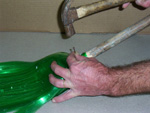 |
| 11. Your broom is ready! |  |
Monday, March 26, 2012
Straw Bale Gardening: Start to Finish
From the YouTube Description:
"Straw bales (not hay bales) are a great place to plant vegetables. Here's my start-to-finish results! The straw is an easy, loose place for the plants to spread out their roots. Also, up on the straw bale there is essentially ZERO weeds to pick. (Note: do NOT use a "hay" bale: unlike straw, the hay has lots of seeds and you will have wheat/oats/grass/etc. growing as weeds in your garden!). Straw bales have some benefits like "raised bed" gardening."
"Straw bales (not hay bales) are a great place to plant vegetables. Here's my start-to-finish results! The straw is an easy, loose place for the plants to spread out their roots. Also, up on the straw bale there is essentially ZERO weeds to pick. (Note: do NOT use a "hay" bale: unlike straw, the hay has lots of seeds and you will have wheat/oats/grass/etc. growing as weeds in your garden!). Straw bales have some benefits like "raised bed" gardening."
Biochar: Nature's Fertiliser
"Bio-char is the carbon structure of a plant after all of the other
elements have been removed. Bio-char permanently stores the carbon in a
beneficial way, in the ground, making it carbon-negative. Bio-char acts
as a hotel for soil microbes. This can be used to enhance soil quality
even in the poorest of soils, without using dangerous and expensive
chemical fertilizers.
When mixed in with the soil, it has the double impact of permanently sequestering large amounts of CO² and improving soil quality, so as to dramatically increase the crop yields and the income that results from sale of the excess produce. Bio-char as a permanent fertilizer has been known to double plant growth. This increases the yields and profitability per square foot. The habitual use of bio-char leads to a virtuous cycle of increasing economic prosperity from year to year, using land resources currently viewed as "unproductive." ...
Making and using bio-char was a tool the ancient Amazon natives used to convert infertile soil into soil that produced in abundance.
This is a simple way to help solve hunger worldwide, through creating local food abundance. Anyone can do it, once you learn how."
When mixed in with the soil, it has the double impact of permanently sequestering large amounts of CO² and improving soil quality, so as to dramatically increase the crop yields and the income that results from sale of the excess produce. Bio-char as a permanent fertilizer has been known to double plant growth. This increases the yields and profitability per square foot. The habitual use of bio-char leads to a virtuous cycle of increasing economic prosperity from year to year, using land resources currently viewed as "unproductive." ...
Making and using bio-char was a tool the ancient Amazon natives used to convert infertile soil into soil that produced in abundance.
This is a simple way to help solve hunger worldwide, through creating local food abundance. Anyone can do it, once you learn how."
Sunday, March 25, 2012
Praying Mantis Helpers
Praying Mantis are eager workers and can take care of the jobs you wish you didn't have to do! This is Permaculture folks.
This video "...shows finding and protecting praying mantis egg cases so the mantis
hatchlings will eat insects in our garden. See how we have organized our
youtube videos to help gardeners at Organotill.org, a unique tool. This
is one of many videos that follow the gardening season month by month
on organotill.org for Kansas City and similar areas. We hope that people
can follow along and work in their own gardens. Organotill.org features
organic no-till methods used at Niles Home for Children's Garden, Tracy
Garden & elsewhere."
Pop Bottle Drip System
 (images via: you grow girl)
(images via: you grow girl)
Unless you’re really conscientious, it’s way too easy to accidentally
kill plants growing in small pots under the brutal heat of the summer
sun, especially in urban environments where reflected heat can dry out
soil fast. A slow-delivering drip irrigation system is the way to go –
and you don’t have to spend a dime. An easy tutorial from You Grow Girl
explains how to use recycled pop bottles.Cob Building / Earth Building Course with Edwards Eco Building
This
short video is from BBC1 INside Out - shows Kate Edwards running one of
her famous cob courses in Norfolk in the UK.
Kate Edwards says, "Wherever you are in the world you can dig it from the Earth and build your own house. How fantastic is that? It can't be any more environmental than that. There's no transportation, no manufacture of materials, there's no energy gone into it. You're just literally digging it and making a house with your bare hands."
Kate Edwards says, "Wherever you are in the world you can dig it from the Earth and build your own house. How fantastic is that? It can't be any more environmental than that. There's no transportation, no manufacture of materials, there's no energy gone into it. You're just literally digging it and making a house with your bare hands."
If you want to find out more
about cob building courses visit Kate Edwards' cob website at
www.edwardscobbuilding.com
Friday, March 23, 2012
Permaculture in Action - Onion Ring for Sunny-Side Up Eggs

Thanks to Apron Strings Blog for this deliciously wonderful idea. Yet another concept to demonstrate what Permaculture is about, how Fukuoka Masanobu puts it, making a thoughtful observation to avoid thoughtless labour. It's not just about gardening, folks!
Thursday, March 22, 2012
Re-Used Dresser as a Garden for Herbs

Permaculture dresser. Dress for success!
Wednesday, March 21, 2012
Orlando Permaculture - Ralphie
Since it's been nearly a year since my last post, I'd like to celebrate my return with some inspiration.
A backyard garden started by "Ralphie" in Orlando, Florida (USA) explaining some of the principles of why permaculture is applied to our environments.
A section from the orlando permaculture documentary viewed at:
http://www.permaculturetravels.com/film/orlperma.html
A backyard garden started by "Ralphie" in Orlando, Florida (USA) explaining some of the principles of why permaculture is applied to our environments.
A section from the orlando permaculture documentary viewed at:
http://www.permaculturetravels.com/film/orlperma.html
Subscribe to:
Posts (Atom)






